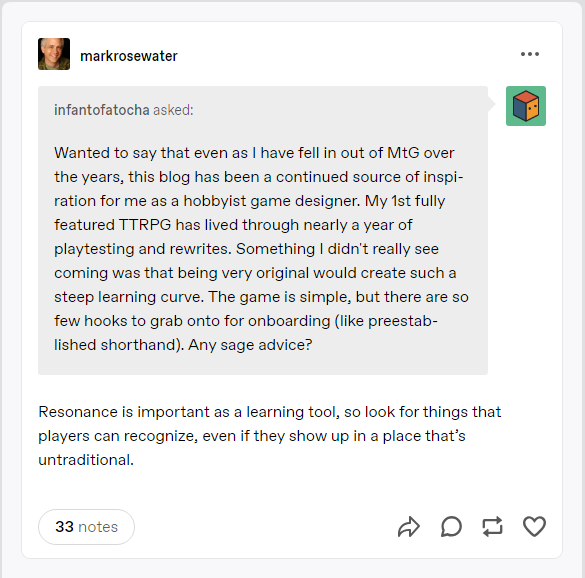Straying from the Path
Welcome. Today, I'm going to do a little bit of a “lessons learned” style blog about how Chronomutants is tricky to learn/teach/sell because it’s perhaps a bit too original. Now, I read a lot of RPG books, and run a bunch of different game systems, and frequently I read a rulebook and say to myself “why would I choose this particular game” and “why do I need another blah blah blah.” The hipster in me looks at popular PbtA and OSR/NSR games and sees stagnation. Most of what I see is B/X with a twist, or 1 page games with a hyper specific theme, or PbtA that is all setting with no mechanics. I learned from Chronomutants that I was wrong. That’s right, you heard it here first, too much innovation can hurt your game. I’m not just talking about popularity (though this also can hurt you here) but in play.
Every design decision has pros and cons, and there are some pretty severe cons I didn’t realize I was creating when I made Chronomutants.
Learning curve. Learning a new game is work. Nobody wants work. For example I ran a Mausritter game for the 1st time last weekend, but it was very easy (even without any preparation) because I have run a lot of similar games. I could look at the module, the stats, etc. and immediately knew what to do. Only had to look up a few particulars (the backpack). If every game were this easy to learn and run for me I’d play different systems all the time, I imagine other people feel similar.
Since I have continued to struggle with this part of the game, I asked for advice from a slightly more accomplished game designer Mr. Mark Rosewater.

Thanks mark
Which brings me to probably the largest issue.
Dissimilarity. Even beyond being tough to learn, having game mechanics that cover well-worn TTRPG territory that don’t work like they do in other games causes both slow play, but more problematic is players struggling to understand the strategy behind the mechanics.

HP/Death/Dying. You don’t have health points, you have luck, every 7 luck you die and one of your 2 special character traits randomly changes. You have to die 4 times to actually lose your character. Luck resets to 7 at the start of each mission. Changing your character as a consequence of taking damage is not the weirdest thing in Chronomutants, but as you’ll see all these little weirdness add up to a somewhat baffling game.
Special items. What if “magic” items were the primary player progression path? Players need to seek these out on their own via a little side quest, and after acquiring one need to opt in to a steep penalty (these things are dangerous) a few times until it turns into a permanent bonus. Besides that this is a little complicated, it’s not what anybody was expecting loot to be.
Encounters. No traditional encounters, you never roll for initiative, you don’t get a turn. Instead players make a plan and roll a skill check. Yet another thing were the cadence and execution are decidedly different from most TTRPG.
Skills. Your character sheet is more like a series of improv prompts for shared storytelling than specific distinct mechanical benefits. It’s more about your starting place for players taking the reins in storytelling. Players can narrate an ace hacker, cunning tracker, or super strong brute; but the difference is in the narration, only Reality Bending and Precognition have special skill rules (you can wager extra risk for better benefits with those).
Player characters are fluid. By default all characters start as random, and they change when they take damage or tinker with reality. Player characters being an ever changing set of improv prompts is something players have a tough time adjusting too. Anything can be changed. Players have the power to change all of reality, but they also are not statistically certain to succeed at doing so. Player characters are so powerful they infringe on traditional GM worldbuilding. This takes some out of the box thinking to understand as a player.
Threats scale with danger not player cleverness. I tried rewarding players for coming up with smart plans, but what I got was players making safe plans. The current version just sets DC by how dangerous something is so that players are free and encouraged to come up with insane plans, which is what I wanted. People tend to hate this idea on paper, but playtesters seem to love it once they get in the spirit of it.
Dice with symbols. Another layer of things that are just less immediately easy to understand. Symbol canceling dice pool requires more deciphering than high or low numbers being just good.
Once you add all this up, you get both a game with a unique feel to play, but also steep onboarding, difficult to parse strategies, AND niche theming. I ended up here because I worked backwards from the play patterns I wanted (making crazy plans) then fit it to the theming I wanted (Gamma World) and designed the mechanics to meet those goals. So I ended up with something pretty alien compared to most of the TTRPG I play, with a whole bunch of innovation. Maybe too much innovation.
Did I reinvent the wheel for no reason? Is it too hard to explain? To learn? In retrospect I don’t think I would have made nearly everything new. It gave me a lot more respect for the “with a twist” trend in a lot of modern design. I feel like maybe I could have built out a complex and crazy and comprehensive time travel subsystem and wielded to a tested frame. OR a wild mutation mechanic and stuck it onto something else that already works.Now I have all these pretty wild things all glued together and it’s probably too much. Certainly too much for my first public game. Should have probably kept the scope down a bit. For one, writing a rulebook without being able to heavily lean on preestablished shorthand complicates things. Not to mention the huge lure of being able to say you can optionally add my thing to a game you already play.
That’s all I got, that I was too ambitious and my hubris made my game extra unlikeable.
Stay safe, stay unlikeable,
-g
Get Chronomutants
Chronomutants
The game about time-traveling weirdos on a mission.
| Status | Released |
| Category | Physical game |
| Author | gary D. Pryor |
| Genre | Role Playing |
| Tags | gamma-world, gary-d-pryor, mutant, Post-apocalyptic, Sci-fi, storygame, Tabletop, Time Travel, Tabletop role-playing game |
| Languages | English |
More posts
- Update Version...Mar 19, 2025
- Version 1.3 is out!Nov 17, 2023
- Saying YesOct 05, 2023
- Unleash the HorrorSep 13, 2023
- Forging Onward From the DarkAug 22, 2023
- What's a Paradox War Anyway?Aug 08, 2023
- How (not) to Write a RulebookJul 25, 2023
- Employee of the Month: The Path to Excellence For the Freelance TimetravelerJul 11, 2023
- Mutation and You. A Guide.Jun 22, 2023

Leave a comment
Log in with itch.io to leave a comment.